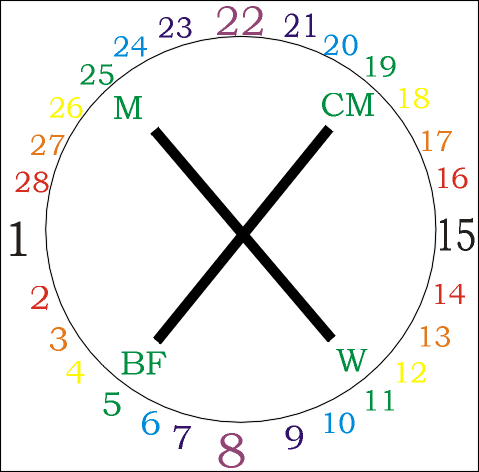
F: Self-consciousness
F: The Unfaithful
11 TCM
25 TCM
| The attributes of the Faculties when Will is at Phase 11 | derived from | modified by | from | description | ||
| Will | The consumer, pyre-builder | 11 | ||||
| Mask | True | Rejection | 25 | CM | 5 | Rhetoric |
| False | Moral indifference | BF | 19 | Persecution | ||
| Creative Mind | True | Moral iconoclasm | 19 | CM | 11 | Emotional intellect |
| False | Self-assertion | BF | 25 | Enforced failure of action | ||
| Body of Fate | Enforced belief | 5 | ||||
| Composite of Faculties | |
|---|---|
| true | The consumer or pyre-builder seeks to deliver rejection, modified by rhetoric, from enforced belief, with the help of moral iconoclasm, modified by emotional intellect. |
| false | The consumer or pyre-builder is misdirected to moral indifference, modified by persecution, because self-assertion, modified by enforced failure of action, is separated from enforced belief. |
 | Attributes of Phase 11 | affects | modifies | |
| Will | The consumer, pyre-builder | 11 | - | |
| Mask | T:
Consciousness of self
F: Self-consciousness | 25 | - | |
| Creative Mind | T:
Emotional intellect
F: The Unfaithful | 19 | 5 FM 11 TCM | |
| Body of Fate | Natural law | 5 | 19 FM 25 TCM | |
See AV B 124-26 & 97.
Spinoza, Savonarola
Yeatsís description of the phase from A Vision |
While Phase 9 was kept from its subjectivity by personal relations, by sensuality, by various kinds of grossness; and Phase 10 by associations of men for practical purposes, and by the emotions that arise out of such associations, or by some tragic love where there is an element of common interest; Phase 11 is impeded by the excitement of conviction, by the contagion of organised belief, or by its interest in Organisation for its own sake. The man of the phase is a half-solitary, one who defends a solitude he cannot or will not inhabit, his Mask being from a phase of abstract belief, which offers him always some bundle of mathematical formulae, or its like, opposed to his nature. It will presently be seen that the man of Phase 25, where the Mask is, creates a system of belief, just as Phase 24 creates a code, to exclude all that is too difficult for dolt or knave; but the man of Phase 11 systematises, runs to some frenzy of conviction, to make intellect, intellect for its own sake, possible, and perhaps, in his rage against rough-and-ready customary thought, to make all but intellect impossible. He will be the antithesis of all this, should he be conquered by his Body of Fate (from Phase 5, where the common instinct first unites itself to reflection), being carried off by some contagion of belief, some general interest, and compelled to substitute for intellectual rage some form of personal pride and so to become the proud prelate of tradition. In Spinoza one finds the phase in its most pure and powerful shape. He saw the divine energy in whatever was the most individual expression of the soul, and spent his life in showing that such expression was for the world's welfare and not, as might seem, a form of anarchy. His Mask, under the influence of his Body of Fate, would force him to seek happiness in submission to something hard and exterior; but the Mask, set free by a Creative Mind that would destroy exterior popular sanction, makes possible for the first time the solitary conception of God. One imagines him among the theologians of his time, who sought always some formula perhaps, some sheepdog for common minds, turning himself into pure wolf, and making for the wilderness. Certainly his pantheism, however pleasing to his own bare bench of scholars, was little likely to help the oratory of any bench of judges or of bishops. Through all his cold definitions, on whose mathematical form he prided himself, one divines a quarrel with the thought of his fathers and his kin, forced upon him perhaps almost to the breaking of his heart: no nature without the stroke of fate divides itself in two. (AV B 124-26) |
See a broader view of the Phase in the consideration of the Phase Triads.